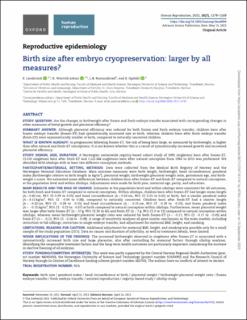| dc.description.abstract | STUDY QUESTION
Are the changes in birthweight after frozen and fresh embryo transfer associated with corresponding changes in other measures of foetal growth and placental efficiency?
SUMMARY ANSWER
Although placental efficiency was reduced for both frozen and fresh embryo transfer, children born after frozen embryo transfer (frozen-ET) had symmetrically increased size at birth, whereas children born after fresh embryo transfer (fresh-ET) were asymmetrically smaller at birth, compared to naturally conceived children.
WHAT IS KNOWN ALREADY
In pregnancies following frozen-ET, the risk of being born large, as measured by birthweight, is higher than after natural and fresh-ET conceptions. It is not known whether this is a result of symmetrically increased growth and increased placental efficiency.
STUDY DESIGN, SIZE, DURATION
A Norwegian nationwide registry-based cohort study of 3093 singletons born after frozen-ET, 15 510 singletons born after fresh-ET and 1 125 366 singletons born after natural conception from 1988 to 2015 was performed. We identified 6334 sibships with at least two different conception methods.
PARTICIPANTS/MATERIALS, SETTING, METHODS
Data were collected from the Medical Birth Registry of Norway and the Norwegian National Education Database. Main outcome measures were birth length, birthweight, head circumference, ponderal index (birthweight relative to birth length in kg/m3), placental weight, birthweight:placental weight ratio, gestational age, and birthweight z-score. We estimated mean differences between children born after frozen-ET and fresh-ET compared to natural conception, at the population level and within sibships. Adjustments were made for birth year, maternal age, parity, and education.
MAIN RESULTS AND THE ROLE OF CHANCE
Estimates at the population level and within sibships were consistent for all outcomes, for both fresh and frozen-ET compared to natural conception. Within sibships, children born after frozen-ET had longer mean length (Δ = 0.42 cm, 95% CI 0.29 to 0.55) and head circumference (Δ = 0.32 cm, 95% CI 0.23 to 0.41) at birth, but a similar ponderal index (Δ = 0.11 kg/m3, 95% CI −0.04 to 0.26), compared to naturally conceived. Children born after fresh-ET had a shorter length (Δ = −0.22 cm, 95% CI −0.29 to −0.15) and head circumference (Δ = −0.15 cm, 95% CI −0.19 to −0.10), and lower ponderal index (Δ = −0.15 kg/m3, 95% CI −0.23 to −0.07) at birth compared to natural conception within sibships. Furthermore, mean placental weight was larger after both frozen-ET (Δ = 37 g, 95% CI 28 to 45) and fresh-ET (Δ = 7 g, 95% CI 2 to 13) compared to natural conception within sibships, whereas mean birthweight:placental weight ratio was reduced for both frozen-ET (Δ = −0.11, 95% CI −0.17 to −0.05) and fresh-ET (Δ = −0.13, 95% CI −0.16 to −0.09). A range of sensitivity analyses all gave similar conclusions as the main models, including restriction to full siblings, restriction to single embryo transfer, and adjustment for maternal BMI, height, and smoking.
LIMITATIONS, REASONS FOR CAUTION
Additional adjustment for maternal BMI, height, and smoking was possible only for a small sample of the study population (15%). Data on causes and duration of infertility, as well as treatment details, were limited.
WIDER IMPLICATIONS OF THE FINDINGS
The increased birthweight observed in singletons after frozen-ET is associated with a symmetrically increased birth size and large placentas, also after controlling for maternal factors through sibship analyses. Identifying the responsible treatment factors and the long-term health outcomes are particularly important considering the increase in elective freezing of all embryos. | en_US |

